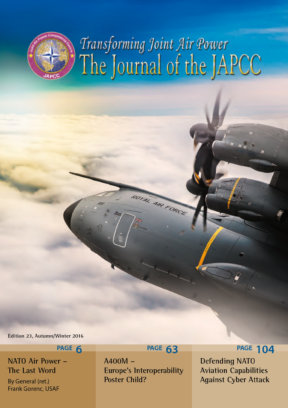Introduction
While the current Force Planning methodology in NATO is highly consistent and stringent, one significant weakness is the system completely depends on the nations to quickly provide sufficient capability1 once a planned contingency is activated or an unforeseen crisis emerges. Assuming a Very High Readiness Joint Task Force should be ‘ready to move the leading elements within two to three days’2 to respond to rapidly emerging challenges, it can be argued the current Force Planning and Force Generation process does not support that assumption. In the past, nations have been willing to offer capability during NATO Force Planning Conferences but have subsequently found it difficult to honour their pledges because of the size of commitment required, competing operational requirements, and/or continuing resource constraints. The Afghanistan experience taught us a failure to effectively generate the right forces can lead to NATO filling critical capability gaps on Deployed Operating Bases (DOBs) or Aerial Ports of Debarkation (APODs) with ad-hoc forces not intended for that purpose. It is a matter of luck that our failings to date have neither being exploited by an adversary nor exposed by incident or accident.
In general, very few NATO nations are equipped or prepared to deploy force elements to rapidly establish and operate a multinational DOB or APOD. This is not only because nations do not have the necessary capabilities in their national inventory, but also because the Alliance as a whole lacks a fundamental and underpinning concept of how to rapidly deploy, establish and operate effectively and efficiently, a national or multinational DOB or APOD.
The NATO Deployable Airbase Activation Module (DAAM) concept might help solve this dilemma. The concept is meant to identify and catalogue the full spectrum of capabilities needed to operate a DOB established on a bare base3 in a complicated and volatile threat environment. DAAM provides a menu of discreet capability modules owned by participating nations from which specific modules may be selected to piece together a complete and cohesive yet lean and efficient base operating support structure at lower cost than recent operations.
Road to DAAM
After the NATO Force Generation challenges experienced during the establishment of APODs at Pristina (Kosovo) and Kabul (Afghanistan), the JAPCC in 2005 proposed the concept of Deployable Airfield Activation Wings (DAAWs). The concept focused on providing an initial entry or airfield opening capability to rapidly establish a DOB or APOD beyond NATO’s territory.4 The intent was to be able to create a functioning airfield quickly by mitigating against the time-consuming NATO Force Generation process. The second-order effect was to prevent duplication of effort while also preventing omission of any essential capability. The project resulted in the creation of detailed Capability Codes during the Capability Requirement Review (CRR) step of the NATO Defence Planning Process (NDPP).
While these proposed DAAW Capability Codes were not adopted or translated into the NATO Concept of Operations for the rapid establishment of a DOB/APOD, the central idea of dividing the overall capability into ‘modules’ that could each be satisfied individually by a contributing nation was not dismissed. Indeed, it was this idea that was re-invigorated by the (new) DAAM concept, which was designed in support of the NDPP and paved the way for what is now described as the NATO Deployable Air Base (NDAB) capability. Associated with the DAAM concept is the Italian-led Smart Defence (SD) Project 1.16 which offers the opportunity to create a multinational pool5, 6 of required NDAB capabilities, for which six nations7 have so far signed a Letter of Intent.8 The European Air Group (EAG) also supports this project by drafting the concept and contributing to the planning of exercises. Also worthy of note (but not particularly based on DAAM), is the UK-led SD project 1.18 that looks at Theatre Opening Capability (TOC).9
DAAM – What’s New?
The most significant innovation of DAAM is the move from a traditional, national-led deployment of a capability – or what happened more often, a combination of disparate or unnecessarily redundant national capabilities – to a more integrated model. It envisages the use of smaller national or multinational modules encompassing all capabilities needed for airbase operations, support and protection, which would come together to create a single NDAB capability. This facilitates rapid activation, deployment, and operation by combining the individual, national force contributions into a predetermined, comprehensive multinational force package. Participating nations will be able to meet their commitments in an effective, efficient manner, while building an effective, efficient multinational NDAB. Thus, the concept could significantly reduce the time gap between Operational Planning, Force Generation, and Deployment phases of an Operation.
The DAAM model, therefore, distinguishes various DOB elements by identifying required ‘Capability Modules’, which are then subdivided into more specific, thematic components that could be delivered by particular ‘Service Teams’ (equipment and personnel). Based on this DAAM idea, the current version of the NDAB Concept of Operations outlines six Capability Modules and 19 Service Teams, as depicted in Table 1.10
The subdivision into single Service Teams allows smaller NATO Nations to develop partial contributions to an NDAB capability instead of taking on the huge burden associated with providing a fully fledged DOB installation. This will hopefully prompt more Allies to commit in advance through NATO Force Planning and help solve the NDAP capability shortfall. However, based on lessons learned in operations and exercises, the above DOB functional capability requirements should be further refined, since more specific DAAM components (Capability Categories and Service Teams) may boost the willingness for national contribution. For example, Force Protection (FP) capability codes could be expanded to include more detail, as is also requested by recently updated FP doctrine.12 An analysis of the NATO DOB at Kandahar (during the recent ISAF mission) shows 40 distinct FP capabilities that could be individually described and served.
As with any operation, the eventual activation of the NDAB capability will be based on specific operational planning once NATO decides to commit forces to manage a particular crises. The related Force Generation process will remain the primary means for identifying certain NDAB Service Teams (personnel and equipment) for deployment. Then the operational planning process will tailor them to specific missions.
Apart from an NDAB Cell at Allied Command Operations (ACO) Headquarters, no new standing NATO entity for NDAB will be established. ACO is also responsible for nominating a Lead Nation for the NDAB for each period of the NRF. The NDAB cell will coordinate with the Lead Nation to ensure optimization of DAAM assets in order to enable the initial training of Service Teams. The North Atlantic Council (NAC) agreed to base the NDAB capability primarily on a combination of national means and resources. To further ease the burden for NDAB contributions, the NAC also endorsed the reimbursement of national expenditures for airbase equipment required to remain in theatre after re-deployment of NATO forces.
Additional Requirements
In order to move the DAAM and NDAB concept forward and succeed, the following key issues should be addressed:
- Review and update existing applicable NATO Policy and Doctrine, as they currently do not sufficiently cover NDAB deployment and operation.
- Educate and train personnel of nationally committed NDAB Service Teams in accordance with NATO standards together with Service Teams from different nations to ensure interoperability of both personnel and equipment; a real multinational DAAM-based NDAB has not been seen in exercises.
- Define and agree on criteria for designating a Lead Nation within each Capability Module, and for the overall NDAB.
- Clarify the role and responsibility of ‘Lead Nations’ in relation to the nationally declared single Service Teams, as far as NDAB activation is concerned. Should only the Lead Nation of a particular NDAB package be triggered for activation, or all single components? Since NATO expects to have more than one declared NDAB in the future, the associated level of coordination required between the foreseen Lead Nations and the diverse Service Teams must not be underestimated.
Conclusion and Outlook
The innovative Smart Defence concept DAAM provides a vehicle NATO can use to advance the development of a viable NDAB capability, delivering a solution that is both effective (the NDAB provides all elements required for reliable and robust function) and resource efficient (there will be no duplication of effort). It will do this by pooling, from multiple nations, the various capabilities required to establish, at short notice, a deployed airbase operating in support of NATO missions abroad. However, at the time of writing this article, only six out of the 28 NATO Nations have signed the DAAM Letter of Intent. Given the statement made at the most recent NATO Summit, that multinational and national initiatives provide an important contribution to capability development and our strengthened posture13, more nations should join the DAAM initiative.
Meanwhile, the basic DAAM idea has to be further developed. Successful DOB installations in ISAF and proven US and UK NDAB models could be used as examples to further refine the list of Capability Codes as well as Service Teams. Furthermore, mission-proven DOB organization charts and detailed operating procedures should be safeguarded in cooperation with the involved NATO Commands in charge.
To make the best use of DAAM-based NDAB packages, Operational Planning, Force Generation, and Deployment processes need to be adopted through revised NATO doctrine. Procedures and standards for Logistics and Command and Control must be reviewed and revised as necessary to support interoperability and cross-service support. Finally, a comprehensive multinational training and exercise programme must be built to develop integration and interoperability of different national combat service support modules, personnel, and leaders, to validate and strengthen the concept.14












